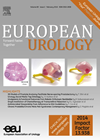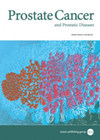
Journal Reviews archive for May 2016
ASAP: is a repeat biopsy necessary?
This study examined the validity of current US and European guidelines on the management of patients diagnosed with atypical small acinar proliferation (ASAP). Current guidance states that these patients should undergo repeat biopsy within three to six months due to...
Active surveillance for renal neoplasms
Renal oncocytomas are the second most common benign renal tumours and they originate from the collecting tubules. They appear genotypically very similar to chromophobe renal cell carcinomas (chRCC), which also contain eosinophilic cells. Oncocytomas are often found incidentally on routine...
Preventive pharmacological therapy for kidney stones
Kidney stones are common, painful and are a chronic disease with a high lifetime risk of recurrence. Without treatment 35-50% of patients experience a second stone within five years of their first experience. Thiazide diuretics, alkali citrate treatment and allopurinol...
Stepwise voltage ramping causes less renal haematomas than fixed maximal voltage ESWL
Extracorporeal shock wave lithotripsy (ESWL) remains the recommended first line treatment for stones <2cm in the renal pelvis and upper or mid-pole calyces (Türk C, Knoll T, Petrik A, et al. European Association of Urology Guidelines on Urolithiasis. 2014). There...
Recurrent urinary tract infections in women
This review article defined women who had recurrent urinary tract infections (UTIs) as having either ≥ two episodes in the last six months or ≥ three episodes in the last 12 months. Using a number of databases, including the Cochrane...
Glans size is an independent risk factor for urethroplasty complications after hypospadias repair
In this analysis, prepubertal patients undergoing hypospadias repair over a four-year period had caliper measurement of glans width taken perioperatively. Multivariate logistic regression analysis was carried out for complications while adjusting for patient age, meatus position or type of repair....
Medical expulsive therapy for paediatric urolithiasis
Children who have kidney stones are likely to have recurrences. Many initial stones are treated conservatively allowing for spontaneous passage of small stones if possible. Doxazocin or tamsulosin are known to dilate the ureter and allow spontaneous passage of stones...
The challenge of psychological problems in enuresis treatment
The first sentence of the conclusion of this review article reads: “In the past decade the role of psychological factors in the pathogenesis of nocturnal enuresis has changed from a primary causal factor to a consequence or comorbidity.” The authors...
Liquid paraffin versus lidocaine
Topical anaesthetics have been used in urology since 1884, when Pease described using “cocaine in a sensitive urethra with charming results”. Since 1949, 2% lidocaine has been increasingly used intraurethrally for cystoscopy and other procedures. This article is a pilot...
Predicting bone scan positivity in non-metastatic CRPC
There is evidence that suggests that early treatment with chemotherapy, immunotherapy or hormone therapy leads to a better response in patients with asymptomatic metastatic castrate resistant prostate cancer (CRPC). This study aimed to predict bone scan positivity in patients with...
Rectal swab testing before prostate biopsy
This study explored the real terms value of rectal swab testing and targeted antibiotic prophylaxis in patients undergoing transrectal ultrasound prostate biopsy in view of increasing bacterial resistance to fluoroquinolones (17.6% in North America, 40% in Hong Kong). The authors...
The potential of statin use in castrate resistant prostate cancer treatment
One of the mechanisms by which prostate cancer achieves castrate resistance is through de novo intratumoral production of androgens. Reactivation of androgen receptors results in promotion of cell survival and proliferation pathways despite castrate serum testosterone levels. As androgen synthesis...










